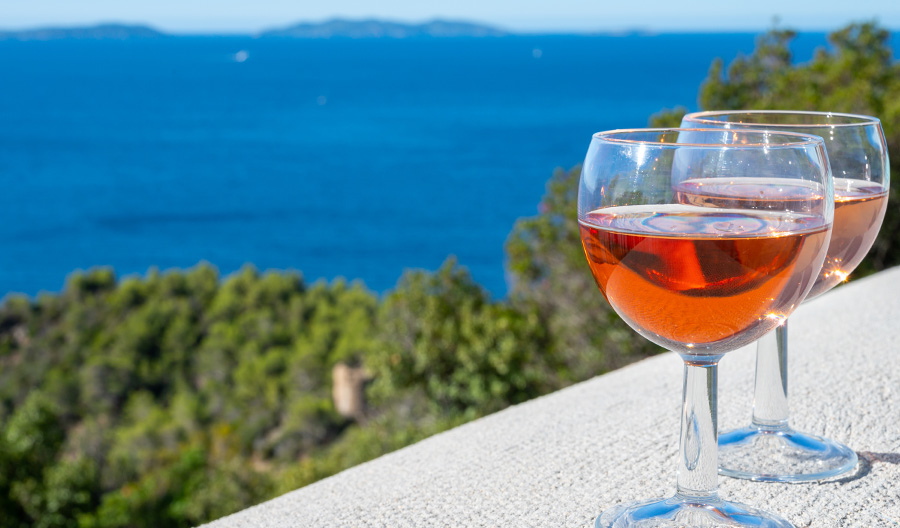Languedoc Rosé is a product of the Languedoc-Roussillon region in Southern France, one of the largest wine-producing areas in the world. This rosé is unique in its diversity due to the wide range of microclimates, soils, and grape varieties present in the region. This rosé is typically a blend of several grape varieties, including Grenache, Syrah, and Cinsault. This blend results in a wine that is complex and balanced, with each grape contributing its unique characteristics to the final product.
The color of Languedoc Rosé can range from a pale, almost translucent pink to a deeper, more robust rose hue. This variation in color is a result of the different winemaking techniques used, including the length of time the grape skins are in contact with the juice. Languedoc Rosé is known for its vibrant and fresh flavor profile. It often exhibits notes of red fruit, citrus, and floral undertones, with a crisp acidity that makes it a refreshing choice for warm weather drinking.
Despite its light and refreshing character, Languedoc Rosé can also display a certain depth and complexity. This is particularly true for rosés produced in the region's hillier areas, where the vines are subject to more extreme weather conditions.
Another unique characteristic of Languedoc Rosé is its versatility when it comes to food pairings. Its balance of fruitiness and acidity makes it a great match for a wide range of dishes, from seafood and grilled meats to spicy Asian cuisine.
Finally, Languedoc Rosé is often praised for its excellent value. Despite its high quality and the skill involved in its production, it is typically more affordable than rosés from other regions, making it a popular choice for wine lovers.

The History of Wine Production in the Languedoc Region
The Languedoc region Southern France has a rich history of wine dating back the productionth to 5 century BC, when the Greeks first introduced viticulture to the area.'s The region favorable Mediterranean climate, diverse soil types, and abundant sunshine provided ideal conditions for growing a variety of grape types.
The Romans, after their arrival in 121 BC, expanded the wine production in Languedoc significantly. They built infrastructure including roads and bridges, which facilitated the transportation of wine and helped establish the region as a major wine producer in the Roman Empire.
During the Middle Ages, the wine produced in Languedoc was highly sought after by the Catholic Church for sacramental purposes. The monastic orders, particularly the Cistercians and the Benedictines, played a crucial role in maintaining vineyards and wine production during this period.
In the 19th century, the Languedoc wine industry suffered a severe blow due to the phylloxera epidemic, a pest that destroyed many vineyards. However, the region managed to recover by grafting resistant American rootstocks to the local vines.
In the 20th century, Languedoc faced another challenge as it became known for producing cheap, bulk wines, which led to a decline in its reputation. However, in the late 20th and early 21st centuries, the region underwent a wine revolution, with a focus on quality over quantity. Many winemakers started to produce high-quality, expressive wines, including the now famous Languedoc Rosé.
Today, Languedoc is the largest wine-producing region in France, accounting for over a third of the country's total wine production. The region is renowned for its diversity of wines, including red, white, rosé, sparkling, and dessert wines, with Languedoc Rosé being particularly celebrated for its unique character and quality.
Food Pairings that Complement Languedoc Rosé
Languedoc Rosé, with its diverse flavor profile ranging from delicate floral notes to vibrant red fruit characteristics, pairs exceptionally well with a variety of foods. Its versatility makes it a favorite for many culinary enthusiasts.
Seafood is a classic pairing for Languedoc Rosé. The wine's crisp acidity and light body complement the delicate flavors of fish and shellfish. Grilled shrimp, seared scallops, or a classic bouillabaisse would make excellent choices.
Another great pairing for Languedoc Rosé is poultry. The wine's subtle fruitiness can enhance the flavor of chicken or turkey dishes. Whether it's a simple roast chicken or a more complex dish like coq au vin, Languedoc Rosé can hold its own.
Cheese is another food that pairs well with this wine. The wine's acidity cuts through the richness of the cheese, creating a balanced flavor experience. Soft cheeses like brie or camembert, or even stronger ones like blue cheese, pair wonderfully with Languedoc Rosé.
Vegetarian dishes also pair well with Languedoc Rosé. The wine's light body and crisp acidity can complement a variety of vegetables, from grilled asparagus to roasted bell peppers. It's also a great match for salads, especially those with vinaigrette dressings.
Lastly, don't forget about dessert. Languedoc Rosé can be a delightful companion to fruit-based desserts. Its light, fruity character can enhance the flavors of dishes like strawberry shortcake or peach cobbler, providing a refreshing finish to a meal.

